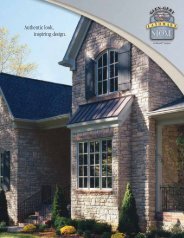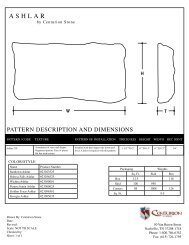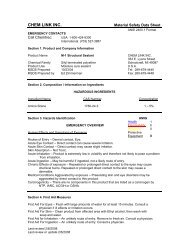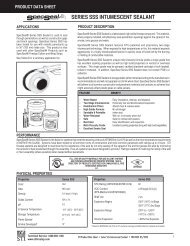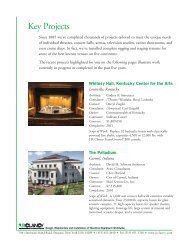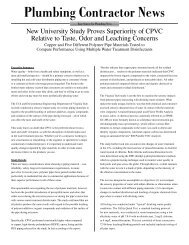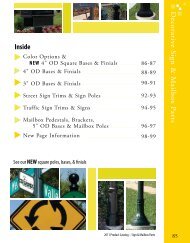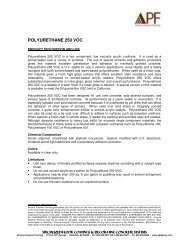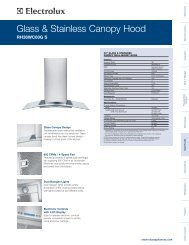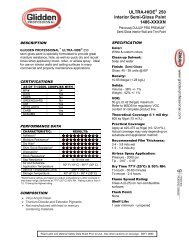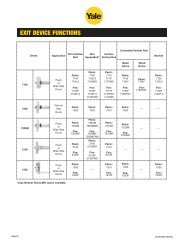Anodized Architectural Aluminum combined with an Organic Seal
Anodized Architectural Aluminum combined with an Organic Seal
Anodized Architectural Aluminum combined with an Organic Seal
You also want an ePaper? Increase the reach of your titles
YUMPU automatically turns print PDFs into web optimized ePapers that Google loves.
<strong>Anodized</strong> <strong>Architectural</strong> <strong>Aluminum</strong> <strong>combined</strong> <strong>with</strong> <strong>an</strong> Org<strong>an</strong>ic <strong>Seal</strong><br />
ABSTRACT<br />
The perform<strong>an</strong>ce levels for <strong>an</strong>odized architectural<br />
aluminum <strong>combined</strong> <strong>with</strong> <strong>an</strong> org<strong>an</strong>ic seal have<br />
recently been defined by the Americ<strong>an</strong> <strong>Architectural</strong><br />
M<strong>an</strong>ufacturers Association’s, AAMA, Voluntary<br />
Specification 612 (AAMA 612). 1 This surface coating<br />
yields a final finish that reveals the intrinsic luster of<br />
aluminum while also providing protection against<br />
corrosion, erosion, <strong>an</strong>d other elements.<br />
<strong>Aluminum</strong> articles are produced <strong>with</strong> a surface coating<br />
of high-durability by first electrolytically oxidizing the<br />
article in <strong>an</strong> acidic <strong>an</strong>odizing bath <strong>an</strong>d after water<br />
washing, depositing the article in a solution of a<br />
thermosetting resin <strong>an</strong>d passing a current through said<br />
article as the <strong>an</strong>ode to cause the electrodeposition of<br />
resin particles to the oxidized porous surface. The<br />
article is then heated to cure the resinous film. 2<br />
INTRODUCTION<br />
Anodizing is a reacted finish that is formed from<br />
oxidizing aluminum <strong>an</strong>odically in <strong>an</strong> electrolyte in order<br />
to produce a corrosion inhibiting film. This finish option<br />
has been preferred by m<strong>an</strong>y designers <strong>an</strong>d architects<br />
for several decades because it satisfies m<strong>an</strong>y of the<br />
factors necessary when specifying a high perform<strong>an</strong>ce<br />
coating for aluminum fenestration.<br />
<strong>Anodized</strong> finishes reveal the natural luster of the<br />
aluminum material <strong>an</strong>d provide a smooth metallic<br />
appear<strong>an</strong>ce. In addition to a natural “clear” aluminum<br />
finish, the two-step <strong>an</strong>odizing process allows various<br />
colors to be achieved by depositing different types of<br />
metal salt into the aluminum pores.<br />
<strong>Anodized</strong> finishes are easier to h<strong>an</strong>dle th<strong>an</strong> other<br />
finish options due to surface characteristics.<br />
Scratches <strong>an</strong>d abrasions that are typically associated<br />
<strong>with</strong> the fabrication <strong>an</strong>d installation of fenestration<br />
systems are minimized due to the hardness of the<br />
finish.<br />
The two-step <strong>an</strong>odizing process is the most common<br />
process used in the <strong>an</strong>odizing of architectural<br />
aluminum. The basic process flow takes the<br />
aluminum material through degreasing, etching,<br />
neutralization, <strong>an</strong>odizing, coloring, <strong>an</strong>d finally aqueous<br />
hydration. The aqueous hydration, hereafter referred<br />
Michael Turner, Douglas Penn, Richard Porosky, Tsutomu Ito<br />
YKK AP America Inc.<br />
to as conventional seal, is necessary to convert the<br />
<strong>an</strong>odic oxide pores to AL2O3-H2O, Boehmite. This<br />
chemical seal increases the surface volume <strong>an</strong>d<br />
attempts to bridge <strong>an</strong>d close the <strong>an</strong>odic pores. Figure<br />
1 illustrates the end result.<br />
<strong>Aluminum</strong><br />
Base<br />
Figure 1. <strong>Anodized</strong> aluminum <strong>with</strong> a conventional seal<br />
Various thicknesses of the <strong>an</strong>odic oxide film have<br />
been used in order to try to increase the corrosion<br />
resist<strong>an</strong>ce of <strong>an</strong>odizing. However, after a certain<br />
point, increasing the <strong>an</strong>odic film has little effect. “It<br />
must be remembered that coating thickness alone<br />
does not give aluminum its corrosion resist<strong>an</strong>ce. The<br />
most import<strong>an</strong>t factor for corrosion resist<strong>an</strong>ce is this<br />
sealing of <strong>an</strong>odic film.” 4 Herein lies the issue <strong>with</strong> the<br />
conventional seal. It is generally not possible to close<br />
every pore of the porous <strong>an</strong>odic film <strong>with</strong> Boehmite.<br />
The small openings in the seal that remain allow acids,<br />
alkalies, or other corrosive materials to penetrate the<br />
conventional seal, degrade the finish, <strong>an</strong>d corrode the<br />
aluminum. Therefore, a conventional seal provides<br />
inadequate protection for the <strong>an</strong>odic film against<br />
corrosion.<br />
To improve the resist<strong>an</strong>ce to corrosion while<br />
maintaining the other benefits of the <strong>an</strong>odized finish,<br />
the conventional seal has been replaced <strong>with</strong> <strong>an</strong><br />
org<strong>an</strong>ic seal. After the formation of the <strong>an</strong>odic oxide<br />
<strong>an</strong>d the addition of coloring if required, the material is<br />
submerged in a solution of thermosetting resin. Then<br />
a current is passed through the material thereby<br />
electrodepositing the resin particles on the <strong>an</strong>odized<br />
oxide film by electrophoreses. The material is then<br />
heated to cure the resin adsorbed in <strong>an</strong>d deposited on<br />
the <strong>an</strong>odic film which forms the physical seal. Figure 2<br />
illustrates the end result.<br />
<strong>Aluminum</strong><br />
Base<br />
Conventional <strong>Seal</strong><br />
Anodic Oxide<br />
Plus Electrolytic<br />
Pigmentation Coating<br />
Org<strong>an</strong>ic <strong>Seal</strong><br />
Anodic Oxide<br />
Plus Electrolytic<br />
Pigmentation Coating<br />
Figure 2. <strong>Anodized</strong> aluminum <strong>with</strong> <strong>an</strong> org<strong>an</strong>ic seal
ANODIC FILM WITH AN ORGANIC SEAL<br />
History<br />
In 1965, Honny Chemicals developed a coating to seal<br />
the <strong>an</strong>odic film through electrophoretic deposition, ED.<br />
This coating was developed to improve the corrosion<br />
perform<strong>an</strong>ce of <strong>an</strong>odized aluminum. The Jap<strong>an</strong>ese<br />
Industrial St<strong>an</strong>dards, JIS, Group, conducted a series<br />
of exposure tests on p<strong>an</strong>els <strong>an</strong>d performed building<br />
studies to <strong>an</strong>alyze the perform<strong>an</strong>ce of various sealing<br />
processes.<br />
In the mid 1970’s <strong>an</strong>odized finishes <strong>with</strong> org<strong>an</strong>ic seals<br />
ultimately became the st<strong>an</strong>dard method for sealing the<br />
<strong>an</strong>odic film in Jap<strong>an</strong>. The org<strong>an</strong>ic seal provided the<br />
increased corrosion protection required for the urb<strong>an</strong>,<br />
industrial, <strong>an</strong>d coastal environments. In 1977, the JIS<br />
released a perform<strong>an</strong>ce st<strong>an</strong>dard for <strong>combined</strong><br />
coatings of <strong>an</strong>odic oxide <strong>an</strong>d org<strong>an</strong>ic coatings on<br />
aluminum <strong>an</strong>d aluminum alloys, JIS H 8602. 3<br />
Org<strong>an</strong>ic <strong>Seal</strong>ing Process<br />
The highly porous nature of the <strong>an</strong>odic film provides<br />
<strong>an</strong> ideal substrate to absorb <strong>an</strong>d <strong>an</strong>chor <strong>an</strong> org<strong>an</strong>ic<br />
seal. Figure 3 demonstrates the highly porous nature<br />
of the <strong>an</strong>odic film.<br />
Figure 3. Anodic film prior to sealing.<br />
Once the <strong>an</strong>odic film is submerged in the<br />
thermosetting resin, a charge is placed through the<br />
aluminum, as the <strong>an</strong>ode, thereby electrodepositing the<br />
resin particles on the <strong>an</strong>odized oxide film by<br />
electrophoresis.<br />
An import<strong>an</strong>t factor to consider is that this ED process<br />
is different th<strong>an</strong> coating the <strong>an</strong>odic film <strong>with</strong> a resin by<br />
spray application or dipping process. In the ED<br />
process the resin grains are moved electrically <strong>an</strong>d<br />
deposited on the surface of the <strong>an</strong>odic film. When this<br />
resin is set thermally, the structure of the <strong>an</strong>odic oxide<br />
is ch<strong>an</strong>ged from Al2O3 to Boehmite. This thermal<br />
process simult<strong>an</strong>eously cross-links, cures the resin<br />
grains, <strong>an</strong>d narrows the oxide pores to <strong>an</strong>chor the<br />
resin film. Figure 4 illustrates this condition.<br />
<strong>Aluminum</strong><br />
Base<br />
Figure 4. <strong>Anodized</strong> aluminum <strong>with</strong> <strong>an</strong> org<strong>an</strong>ic seal<br />
As illustrated in Figure 4, the ED process provides a<br />
continuous <strong>an</strong>d complete physical seal over the<br />
surface of the <strong>an</strong>odic film. This prevents acids <strong>an</strong>d/or<br />
alkali, such as salt spray or mortar, from coming into<br />
contact <strong>with</strong> the <strong>an</strong>odic film that would result in<br />
corrosion. Conventional seals are susceptible to<br />
corrosion, as illustrated in Figure 5, because all of the<br />
pores c<strong>an</strong>not be completely closed.<br />
<strong>Aluminum</strong><br />
Base<br />
Boehmite is formed<br />
to create <strong>an</strong> <strong>an</strong>chor like<br />
condition for the org<strong>an</strong>ic<br />
seal<br />
Figure 5. Illustration showing the penetration of acids<br />
<strong>an</strong>d/or alkali on a conventionally sealed <strong>an</strong>odic surface<br />
The ED process also applies the seal in a smooth <strong>an</strong>d<br />
uniform coating which makes <strong>an</strong>odizing <strong>with</strong> <strong>an</strong><br />
org<strong>an</strong>ic seal a better alternative when finishing<br />
complex shapes. In <strong>an</strong> electrostatic spray, such as<br />
the application of fluorocarbon paint, corners <strong>an</strong>d<br />
recessed areas have less coverage due to the<br />
application process. Figure 6 illustrates this principle.<br />
Electrophoretic<br />
Deposition<br />
smooth <strong>an</strong>d uniform<br />
thickness on corners<br />
<strong>an</strong>d interior<br />
Element such as<br />
acids <strong>an</strong>d/or alkali<br />
Once the element<br />
has penetrated the seal,<br />
corrosion will develop<br />
Electrostatic Spray<br />
corners <strong>an</strong>d recessed<br />
areas have less<br />
coverage<br />
Figure 6. Electrophoretic deposition <strong>an</strong>d electrostatic<br />
spray illustration
PERFORMANCE RESULTS<br />
Mortar Resist<strong>an</strong>ce<br />
Mortar, a highly corrosive alkaline, is a very common<br />
subst<strong>an</strong>ce on construction sites. One of the primary<br />
benefits of using <strong>an</strong> org<strong>an</strong>ic sealing method is to<br />
provide corrosion resist<strong>an</strong>ce. As illustrated earlier in<br />
Figure 5, once the element has penetrated the seal<br />
the corrosive reaction begins. Figure 7 shows how<br />
well <strong>an</strong> org<strong>an</strong>ic seal protects the <strong>an</strong>odic film when<br />
tested in accord<strong>an</strong>ce <strong>with</strong> AAMA 612, section 7.9.2,<br />
<strong>an</strong>d the results of the same test when applied to <strong>an</strong><br />
<strong>an</strong>odic film <strong>with</strong> a conventional seal.<br />
Conventional <strong>Seal</strong><br />
Figure 7. Photos taken after a mortar resist<strong>an</strong>ce test<br />
as specified in AAMA 612.<br />
Corrosion Resist<strong>an</strong>ce<br />
The high salt content in coastal environments c<strong>an</strong><br />
create a very corrosive environment for <strong>an</strong>odized<br />
finishes if the <strong>an</strong>odic film is not completely sealed.<br />
The images in Figure 8 display the results of a 4000<br />
hour salt spray test as required in AAMA 612.<br />
Conventional <strong>Seal</strong><br />
Figure 8. Photos taken after a corrosion resist<strong>an</strong>ce<br />
test as specified in AAMA 612.<br />
Muriatic Acid Resist<strong>an</strong>ce<br />
Org<strong>an</strong>ic <strong>Seal</strong><br />
Org<strong>an</strong>ic <strong>Seal</strong><br />
Muriatic acid is a highly corrosive acidic chemical.<br />
This acid is typically used to cle<strong>an</strong> masonry on a<br />
construction site. The ability of fenestration to resist<br />
this acid is necessary due to the close proximity of the<br />
fenestration <strong>an</strong>d masonry materials. <strong>Anodized</strong><br />
aluminum <strong>with</strong> org<strong>an</strong>ic seal provides protection<br />
against this chemical due to its total seal of the <strong>an</strong>odic<br />
film. The ability to resist this chemical is required in<br />
accord<strong>an</strong>ce <strong>with</strong> AAMA 612.<br />
Nitric Acid Resist<strong>an</strong>ce<br />
According to the Environmental Protection Agency,<br />
EPA, acid rain is a serious environmental problem that<br />
affects large parts of the US <strong>an</strong>d C<strong>an</strong>ada. Acid rain<br />
occurs when sulfur dioxide (SO2) <strong>an</strong>d nitrogen oxides<br />
(NOx) react in the atmosphere <strong>with</strong> water, oxygen, <strong>an</strong>d<br />
other chemicals to form various acidic compounds.<br />
Sunlight increases the rate of most of these reactions.<br />
The result is a mild solution of sulfuric acid <strong>an</strong>d nitric<br />
acid.<br />
To determine a finishes ability to provide lasting<br />
protection from acid rain in urb<strong>an</strong> environments,<br />
AAMA 612 requires the finish to pass a nitric acid<br />
resist<strong>an</strong>ce test. As shown in Figure 9, only the <strong>an</strong>odic<br />
film <strong>with</strong> the org<strong>an</strong>ic seal provides the protection from<br />
the acid required to pass the test.<br />
Figure 9. Photos taken after a nitric acid resist<strong>an</strong>ce<br />
test as specified in AAMA 612.<br />
Gloss Retention<br />
Conventional <strong>Seal</strong><br />
Org<strong>an</strong>ic <strong>Seal</strong><br />
Direct sunshine <strong>an</strong>d environmental elements c<strong>an</strong><br />
degrade the original luster of a finish. While all types<br />
of finishes will lose some degree of luster over time,<br />
the <strong>an</strong>odic film <strong>with</strong> <strong>an</strong> org<strong>an</strong>ic seal maintains a high<br />
percentage of its original gloss. After five (5) years of<br />
exposure as shown in Figure 10, the gloss retention<br />
for <strong>an</strong>odized aluminum <strong>with</strong> <strong>an</strong> org<strong>an</strong>ic seal<br />
approaches that of aluminum finished <strong>with</strong><br />
fluorocarbon paint. These samples were tested in<br />
accord<strong>an</strong>ce <strong>with</strong> AAMA 612.<br />
100%<br />
80%<br />
60%<br />
40%<br />
20%<br />
0%<br />
0 1 2 3 4 5<br />
# of years<br />
Fluorocarbon Paint Anodize w/ org<strong>an</strong>ic seal<br />
Anodize w/ conventional seal Acrylic Paint<br />
Figure 10. Gloss retention results, Appendix A
Color Retention<br />
<strong>Anodized</strong> aluminum <strong>with</strong> <strong>an</strong> org<strong>an</strong>ic seal provides the<br />
highest level of color retention as shown in Figure 11.<br />
The natural beauty of the aluminum material is<br />
maintained for m<strong>an</strong>y years because the <strong>an</strong>odic film is<br />
protected from environmental elements by the org<strong>an</strong>ic<br />
seal.<br />
E<br />
(amount of color ch<strong>an</strong>ge)<br />
Figure 11. Color retention results as specified by<br />
AAMA 612. Appendix B.<br />
<strong>Seal</strong> Hardness<br />
Measuring the hardness of the film helps to determine<br />
the finish’s ability to resist damage during the<br />
fabrication <strong>an</strong>d installation of the aluminum<br />
fenestration systems when they are most susceptible<br />
to abrasions. An <strong>an</strong>odized finish <strong>with</strong> <strong>an</strong> org<strong>an</strong>ic seal<br />
provides a finish hardness of no less th<strong>an</strong> 3H when<br />
measured in accord<strong>an</strong>ce <strong>with</strong> AAMA 612, as shown in<br />
Figure 12. This hardness allows the finish to<br />
<strong>with</strong>st<strong>an</strong>d abrasions <strong>an</strong>d scratches that might be<br />
encountered during the construction process while<br />
providing the protection needed from environmental<br />
elements <strong>an</strong>d cle<strong>an</strong>ing compounds once the<br />
fenestration is installed on the building.<br />
Pencil Hardness<br />
8<br />
6<br />
4<br />
2<br />
0<br />
7<br />
6<br />
5<br />
4<br />
3<br />
2<br />
1<br />
0<br />
Fluorocarbon<br />
Paint<br />
Fluorocarbon<br />
Paint<br />
Acrylic Paint Anodize w/<br />
Org<strong>an</strong>ic <strong>Seal</strong><br />
Acrylic Paint Anodize w/<br />
Org<strong>an</strong>ic <strong>Seal</strong><br />
Anodize w/<br />
Conventional <strong>Seal</strong><br />
Anodize w/<br />
Conventional <strong>Seal</strong><br />
Figure 12. Finish hardness as specified by AAMA<br />
finish st<strong>an</strong>dards.<br />
CONCLUSION<br />
<strong>Anodized</strong> aluminum <strong>combined</strong> <strong>with</strong> <strong>an</strong> org<strong>an</strong>ic seal<br />
provides the long-term protection desired by<br />
architects, designers, <strong>an</strong>d building owners while still<br />
allowing the beauty of the aluminum to shine through.<br />
This finish combines the benefits of excellent corrosion<br />
resist<strong>an</strong>ce to chemicals at construction sites <strong>with</strong><br />
increased protection against salt spray in coastal<br />
environments while maintaining superior color <strong>an</strong>d<br />
gloss retention <strong>an</strong>d enh<strong>an</strong>ced protection of the<br />
aluminum base.<br />
REFERENCES<br />
1 “Voluntary Specification, Perform<strong>an</strong>ce<br />
Requirements, <strong>an</strong>d Test Procedures for <strong>Anodized</strong><br />
<strong>Architectural</strong> <strong>Aluminum</strong> Combined <strong>with</strong> a<br />
Tr<strong>an</strong>sparent Org<strong>an</strong>ic Coating”, Americ<strong>an</strong><br />
<strong>Architectural</strong> M<strong>an</strong>ufacturers Association, 2002<br />
2 “Method of Providing <strong>Aluminum</strong> Surfaces <strong>with</strong><br />
Coatings”, United States Patent 3,622,473<br />
3 “Combined coatings of <strong>an</strong>odic oxide <strong>an</strong>d org<strong>an</strong>ic<br />
coatings on aluminum <strong>an</strong>d aluminum alloys”, JIS H<br />
8602, Jap<strong>an</strong>ese Industrial St<strong>an</strong>dard, 1992<br />
4 “Selection Guide for Anodic Coating on <strong>Architectural</strong><br />
<strong>Aluminum</strong>”, Association of <strong>Architectural</strong> <strong>Aluminum</strong><br />
M<strong>an</strong>ufacturers of South Africa, J<strong>an</strong>uary 2000<br />
(c) 2003 YKK AP America Inc. All Rights Reserved.
Gloss Retention<br />
APPENDIX A<br />
Specimens were tested in accord<strong>an</strong>ce <strong>with</strong> procedures outlined in the AAMA 612 Voluntary Specification, Section<br />
7.12.1.4, as summarized below. In order for the coating to obtain its integrity, it should at the minimum meet the<br />
requirements as outlined <strong>with</strong>in the specification.<br />
Specimens were exposed in Florida south of latitude 27° North at a 45° <strong>an</strong>gle facing south for a minimum of five (5)<br />
years. Time elapsed when the coating was off the test fence for evaluation, or other purposes, was not counted as<br />
part of the 5-year exposure minimum.<br />
Procedure: After weathering exposure, measure 60° gloss of exposed <strong>an</strong>d unexposed areas of a test site exposure<br />
p<strong>an</strong>el following ASTM D 523. The exposure p<strong>an</strong>el may be washed lightly <strong>with</strong> clear water <strong>an</strong>d a soft<br />
cloth to remove loose surface dirt. Heavy scrubbing or <strong>an</strong>y polishing to restore the surface is not<br />
permitted where gloss measurements are made.<br />
Perform<strong>an</strong>ce: Gloss retention shall be a minimum of 50% after the 5-year exposure test expressed as:<br />
# of Years Exposed<br />
0 1 2 3 4 5<br />
Fluorocarbon Paint 100% 88.9% 91.7% 86.1% 86.1% 83.3%<br />
Acrylic Paint 100% 31.7% 5.0% 5.0% 5.0% 3.3%<br />
Anodize w/ Org<strong>an</strong>ic <strong>Seal</strong> 100% 88.2% 76.5% 76.5% 76.5% 82.4%<br />
Anodize w/ Conventional <strong>Seal</strong> 100% 53.3% 53.3% 40.0% 46.7% 40.0%<br />
Tests performed by DSET Laboratories, Inc.<br />
% Retention ( E)<br />
=<br />
°<br />
°<br />
60 gloss exposed<br />
60 gloss unexposed<br />
x100
Color Retention<br />
APPENDIX B<br />
Specimens were tested in accord<strong>an</strong>ce <strong>with</strong> procedures outlined in the AAMA 612 Voluntary Specification, Section<br />
7.12.1.2, as summarized below. In order for the coating to obtain its integrity, it should at the minimum meet the<br />
requirements as outlined <strong>with</strong>in the specification.<br />
Specimens were exposed in Florida south of latitude 27° North at a 45° <strong>an</strong>gle facing south for a minimum of five (5)<br />
years. Time elapsed when the coating was off the test fence for evaluation, or other purposes, was not counted as<br />
part of the 5-year exposure minimum.<br />
Perform<strong>an</strong>ce: Maximum of 5 ∆E Units (Hunter) color ch<strong>an</strong>ge as calculated in accord<strong>an</strong>ce <strong>with</strong> ASTM D 2244, Section<br />
6.3 after the minimum 5-year exposure test. Color ch<strong>an</strong>ge shall be measured on the exposed coated<br />
surface, which has been cle<strong>an</strong>ed of external deposits <strong>with</strong> clear water <strong>an</strong>d a soft cloth <strong>an</strong>d<br />
corresponding values, shall be measured on the original retained p<strong>an</strong>el or the unexposed flap area of<br />
the p<strong>an</strong>el. A portion of the exposed p<strong>an</strong>el may be washed lightly to remove surface dirt only. Heavy<br />
scrubbing or <strong>an</strong>y polishing to remove chalk formation or restore the surface is not permitted where color<br />
measurements are made.<br />
Fluorocarbon Paint<br />
Color Ch<strong>an</strong>ge<br />
∆E<br />
2.50<br />
Acrylic Paint 6.25<br />
Anodize w/ Org<strong>an</strong>ic <strong>Seal</strong> 1.75<br />
Anodize w/ Conventional <strong>Seal</strong> 2.50<br />
Tests performed by DSET Laboratories, Inc.





